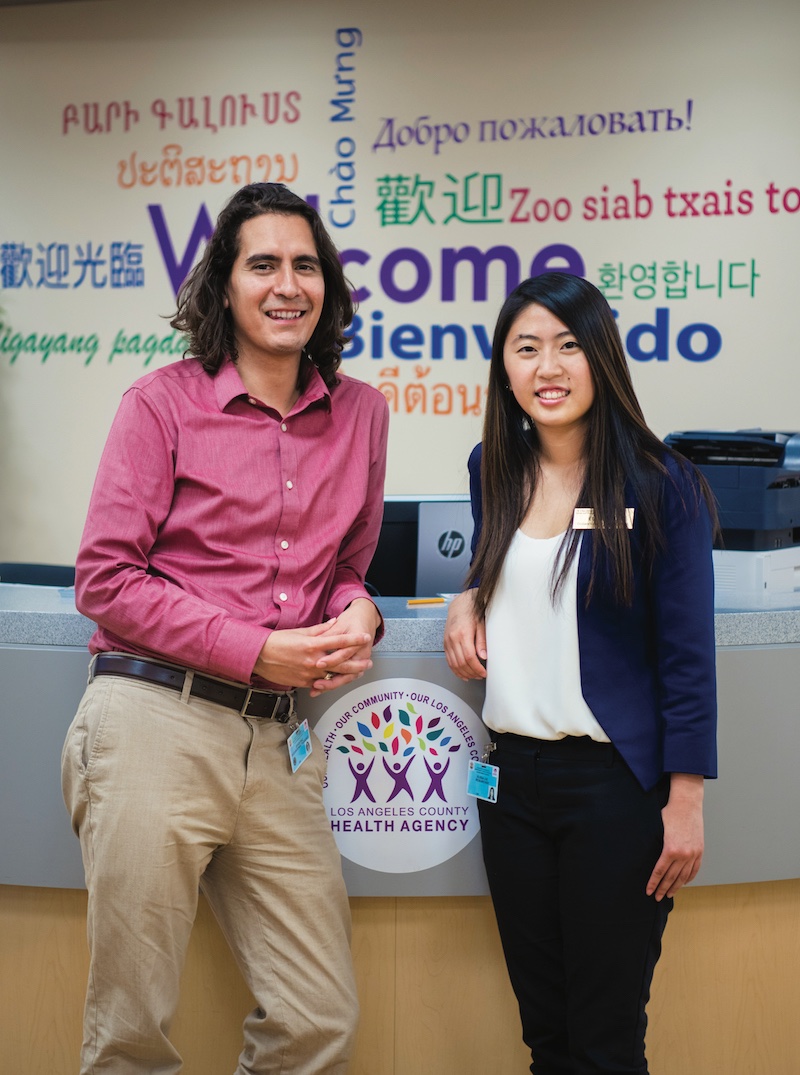Public Service Announcement
Student fellowship project focuses on stream-lining occupational therapy services — starting with diabetes patients at Los Angeles County+USC Medical Center — within public health systems.
By Jamie Wetherbe MA ’04
Elissa Lee MA ’19 has long had an interest in health issues that disproportionately affect low-income patients. While working for several different non-profits, health care and social services agencies in the Bay Area, she started seeing the same patients returning again and again.
“There was this revolving door syndrome,” she says. “Patients would come in for one thing, but the underlying issue wasn’t addressed, so they would come back. That’s why I wanted to pursue occupational therapy at USC, because there are more preventive treatments, including the research we’re doing now.”
In April, Lee became the first occupational therapy student to receive the Gehr Student Innovator Award from the Keck School of Medicine of USC. The award includes a six-week fellowship, during which Lee will implement a new project focused on low-income patients with diabetes seen at the Los Angeles County+USC Medical Center’s Adult West clinic.
“Diabetes is a such a complex disease,” Lee says. “Often when patients come into primary care — especially at L.A. County — doctors have to treat multiple medical conditions and don’t really have the time to help patients navigate changes in daily habits.”
Making inroads
Successfully managing diabetes requires incorporating a constellation of health behaviors — including diet, exercise and medication routines — into a patient’s life. What sounds deceptively simple can be especially difficult due to obstacles that patients of lower socioeconomic status face.
Lee is being mentored by Assistant Professor Beth Pyatak MA ’04, PhD ’10 who, for the past year, has been implementing a pilot study integrating occupational therapists into the Adult West clinic.
“OT has been trying to make inroads into primary care for a long time, but we haven’t had a lot of evidence to point to that demonstrates our value in that setting,” says Pyatak, who leads USC Chan’s Lifestyle Redesign for Chronic Conditions research team. “We have interventions that could help people in a primary care setting, but this is one of the first examples of a project that is rigorously evaluating the impact of having an OT embedded within the care team at the [Adult West] clinic.”
While more research and data need to be analyzed, results from the study so far have been positive — not just for patients, but for the clinic.
“We’ve seen 80 percent of patients have significant improvements in their blood sugar levels,” Pyatak says.
Bringing OTs in the primary care mix also allows the team of providers to practice more effectively.
“They can better understand what their patients need,” Pyatak adds. “And they want to continue having an OT in the clinic, so that’s a significant outcome as well.”
The personal touch
During the year-long study, occupational therapists, including Associate Research Professor Jesús Díaz MA ’08, OTD ’09, have worked alongside Adult West patients with uncontrolled diabetes to provide highly personalized health care strategies.
“We try to make and break habits,” Díaz says. “We look at patients’ life circumstances and day-to-day activities, and try to infuse healthy strategies as opposed to making generic recommendations.”
A large part of providing occupational therapy to patients in the clinic is navigating a variety of everyday circumstances and barriers.
“For example, if you work long hours and don’t have a break to take your insulin or check your blood sugar levels,” Lee says. “Or you need to exercise, but your neighborhood isn’t safe to go take a walk. It’s looking at these types of issues.”
Not only are these individualized interventions improving blood sugar levels, they’re giving patients a better sense of control over the disease.
“We want people to feel confident that this is something they can manage,” Díaz says. “Everyone we work with wants to have better control of their diabetes — they’re just having difficulty doing so.”
Guide for integration
The team is also looking to expand primary care OT for other chronic conditions, including pain management and smoking cessation.
Part of Lee’s fellowship — which is administered by the aptly-named Gehr Family Center for Health System Science — will help do just that. She is writing a manual of best practices and procedures for implementing occupational therapy within primary care sites at public clinics and health systems.
“It’s a guide for how to get started,” Lee says. “We’re analyzing how OT an be utilized in certain settings, and putting these pieces together so other clinics can create a similar service.”
This vision is in line with the mission of the Los Angeles County Department of Health Services, the nation’s second largest municipal health system composed of 19 centers and four hospitals, which continues expanding resources and care to treat chronic conditions.
OT’s involvement in the care of chronic conditions can also help lift some of the stigma and fear.
“There are a lot of misconceptions about diabetes, and I hope our research will help patients feel empowered to make lifestyle changes,” Lee says. “I hope that we can help people manage their care well and live healthy and meaningful lives.”
⋯







